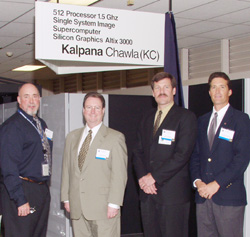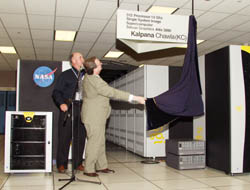NASA Dedicates Supercomputer to 'KC' to the memory of astronaut Kalpana Chawla


Scott Hubbard (second from left) poses with, left to right, Walt Brooks,
Anthony Robbins (SGI), and
Tom Edwards at the 'Kalpana' supercomputer dedication.
NASA Ames Center Director G. Scott Hubbard unveils the SGI Altix 3000
supercomputer named for Kalpana 'KC' Chawla.
Nasa, July 26, 2004
Neena ShardaIn a ceremony on May 12, 2004, NASA dedicated its new Altix supercomputer to the memory of astronaut Kalpana 'KC' Chawla, one of the seven crew members aboard the Space Shuttle Columbia, lost Feb. 1, 2003.
Before joining the astronaut program, Chawla worked as an aerospace engineer at NASA Ames from 1988 to 1995. Chawla served as a flight engineer and mission specialist aboard Columbia and was the first Indian-born woman to fly in space.
"It is indeed an honor to name NASA's new SGI Altix 3000 supercomputer after Kalpana Chawla," said Ames Center Director G. Scott Hubbard. "She was not only a member of the NASA family, but also a special member of our own Ames family. We all miss her and her many contributions to the agency."
At Ames, Chawla had the challenging task of computing the airflow surrounding a jet-supported, delta-wing aircraft during landing. During an interview in 1995, Chawla predicted that her exposure to a wide variety of computer systems at Ames would be especially useful to her as an astronaut.
Of the dozens of experiments successfully conducted by the Columbia crew, Chawla's favorite was the Israeli Mediterranean Dust Experiment, which involved pointing a camera at Earth to study the effects of dust on weather and the environment.
"Fittingly, the SGI Altix 3000 supercomputer that will be named 'Kalpana' is being used to develop substantially more capable simulation models to better assess the evolution and behavior of the Earth's climate system," said Ghassem Asrar, NASA's Deputy Associate Administrator for Earth Science.
The new supercomputer is being used for a group effort by NASA Headquarters, NASA's Jet Propulsion Laboratory (JPL), Pasadena, Calif., NASA Ames and NASA Goddard Space Flight Center, Greenbelt, Md., to deliver high-resolution ocean analysis in the framework of the ECCO (Estimating the Circulation and Climate of the Ocean) Consortium, which involves JPL, the Massachusetts Institute of Technology, Cambridge, Mass., and the Scripps Institute of Oceanography, La Jolla, Calif.
Naming the new supercomputer 'Kalpana' follows a long tradition at the research center of naming its new supercomputers after pioneers in the supercomputer industry or individuals who have significantly contributed to research at Ames.
The following are the Ames Research Center's named supercomputers:
'Chapman,' an SGI Origin 3000, 1,024-processor single-image, shared memory system named after Dr. Dean Chapman, a former director of astronautics at Ames who developed heat protection systems for the space shuttle
'Lomax,' a 512-processor SGI Origin 2000 supercomputer named after Dr. Harvard Lomax, a pioneer in computational fluid dynamics who also worked at Ames
'Steger,' a 128-processor Origin 2800 supercomputer named after Joseph Steger, whose work in computational technology revolutionized the use of computers to solve complex aerospace problems
'Lou,' the main production storage system at the NASA Advanced Supercomputing Division named after Ames research scientist Louis Lopez
'Grace,' a 64-processor Origin 2000 supercomputer named after Grace Hopper, a pioneer in computer science
'Turing,' a 24-processor SGI Origin 2000 supercomputer named for Alan Turing, a mathematician and early computer pioneer
"With the addition of the SGI Altix system, NASA's high-end computing testbed activities in support of the agency's science and engineering missions are greatly enhanced," said Walt Brooks, chief of the NASA Advanced Supercomputing (NAS) Division at NASA Ames. "Thanks to its outstanding performance capabilities, this supercomputer is helping NASA achieve breakthrough results to meet major challenges in climate and ocean modeling and aerospace vehicle design," Brooks added.